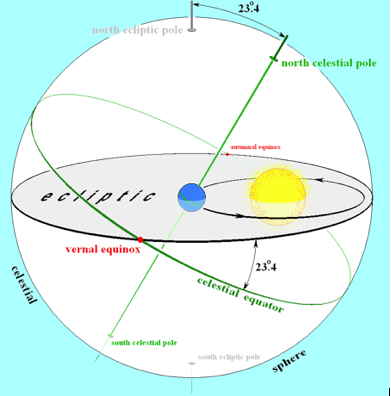All my life I have been a geek that wants to know how and why something works, not just that it works. I have applied my quest for understanding to everything I have learned and experienced, including my spiritual path and even Geomancy. So, as I created my own worksheet that does Geomancy calculations, I began to learn what each term meant and look at how it needed to be calculated. This article is a result of that quest for understanding.
Secrets of Sacred Geometry states that in order to calculate the North Azimuth, which is the angle from true north that the sun will rise on the summer solstice, the value of the Ecliptic must be determined. The Ecliptic Angle is approximately 23.439, with minor variations within 10 minutes (0.167 degrees) due to the wobbling of the earth around its axis, and this value will not change in the next hundred years1.
So what is the Geomancy Ecliptic? Why does its value change only once every century? And how is the Ecliptic calculated?
In astronomical terms, the Ecliptic is the plane of the earth’s orbit around the sun[1] with minor variations averaged out. From an observer’s point of view on earth, the annual travel of the sun moves along the ecliptic through the fixed stars of the cosmos[2]. The importance of the Zodiac signs is that they are the constellations on the Ecliptic that the sun appears to move through over the course of a year.
The Geomancy Ecliptic Angle is also called the earth’s axial tilt, axial inclination, and the obliquity of the ecliptic. In astronomy, this is the angle between an object’s rotational axis and its orbital axis, or equivalently, between its equatorial plane and its orbital plane[3]. The reason we have seasons is because of the axial tilt. Otherwise, we would have a constant, year-round climate with temperatures depending on the latitude. The relationship between the axial tilt and the ecliptic plane is shown in the picture below[4] where the axial tilt is estimated to be 23.4 degrees.

Earth’s axial tilt wobbles around itself due to the gravitational forces of the sun, moon, planets, and other celestial objects. The axial tilt oscillates between 22.1 and 24.5 degrees on a 41,000-year cycle[5], and the angle is currently declining. This means the angle is only changing 0.000058536585 degrees per year. So, between 2000 and 2100, the axial tilt has only changed 0.0058536585 degrees, which only affects the third significant digit and would result in the value 24.434. This explains why the calculation is only updated every hundred years as anything would not be significant. In my quest for an accurate formula for the Ecliptic, I found a website that gives the daily obliquity as “Today, on September 7, 2020, at noon, Earth's axial tilt, or mean obliquity was 23.43659° or
23°26'11.7". Earth's mean obliquity today is about 0.00001°, or 0.04", less than 30 days ago.” [6] Unfortunately they don’t give the formulas for their calculations.
While searching for the obliquity calculation for the earth, I found several interesting articles that gave calculations for the obliquity of asteroids[7], planets, satellites, and even comets[8]. Very cool information, but I don’t plan to do Geomancy on the next passing comet.
The American Meteorological Society (AMS) gives this formula for earth’s obliquity:
23°27’08.26” – 0.4686 (t – 1900)”
where t is the year for which the obliquity is desired[9]. So, according to this formula, the obliquity for 2020 is 23.4366744 and the value for 2000 is 24.4392778.
The Astronomical Almanac 2010[10],from the Jet Propulsion Laboratory (JPL) specifies the obliquity to be:
ε = 23° 26′ 21.406″ − 46.836769″ T − 0.0001831″ T2 + 0.00200340″ T3
− 5.76″ × 10−7 T4 − 4.34″ × 10−8 T5
where T is Julian centuries from J2000.0. Solving for 2000, I got an obliquity = 23.4392794 and the value for 2020, after calculating 2100 and using a proportion, gives 23.4366775. When I requested to create the ephemeris for earth from the Jet Propulsion Laboratory, which uses all its data tracking for thousands of celestial objects, I got the value: 23.4392911.[10] I believe this is a much more accurate value and uses a more robust calculation than the formula from 2010.
In conclusion, the Geomancy Ecliptic Angle has now been defined in astronomical terms with a calculation that explains why it is changed only once per century. I believe JPLs calculations of the ecliptic are more accurate over the centuries due to the fact JPL is responsible for tracking thousands of pieces of space junk, debris, satellites, comets, asteroids, moons, planets, and more to ensure the safe travels of NASA’s spacecraft. If more precision is needed, I think the American Meteorological Society formula gives a good annual approximation and the calculation is quicker and easier than the JPL formula. Overall, both the JPL and the AMS formulas for the year 2000 match the Ecliptic value given in Secrets of Sacred Geometry to three decimal places.
[1] USNO Nautical Almanac Office; UK Hydrographic Office, HM Nautical Almanac Office (2008). The Astronomical Almanac for the Year 2010. GPO. p. M5. ISBN 978-0-7077-4082-9. [2] ‘The Ecliptic: the Sun's Annual Path on the Celestial Sphere’, http://community.dur.ac.uk/john.lucey/users/solar_year.html, (6 September 2020) [3] U.S. Naval Observatory Nautical Almanac Office (1992). P. Kenneth Seidelmann (ed.). Explanatory Supplement to the Astronomical Almanac. University Science Books. p. 733. ISBN 978-0-935702-68-2. [1] ‘File: Earths orbit and ecliptic.PNG’, https://en.wikipedia.org/wiki/File:Earths_orbit_and_ecliptic.PNG, (6 September 2020) [4] Alan Buis, NASA's Jet Propulsion Laboratory, “Milankovitch (Orbital) Cycles and Their Role in Earth's Climate”, https://climate.nasa.gov/news/2948/milankovitch-orbital-cycles-and-their-role-in-earths-climate, 7 September 2020. [5] "Earth Is tilted". https://www.timeanddate.com/astronomy/axial-tilt-obliquity.html. 7 September 2020 [6] C. Lhotka, J. Souchay and A. Shahsavari, “Obliquity, precession rate, and nutation coefficients for a set of 100 asteroids”, https://www.aanda.org/articles/aa/full_html/2013/08/aa21205-13/aa21205-13.html, (7 September 2020) [7] Jet Propulsion Laboratory, “HORIZONS Web-Interface”, https://ssd.jpl.nasa.gov/horizons.cgi, (7 September 2020) [8] American Meteorological Society, “obliquity of the ecliptic”, http://glossary.ametsoc.org/wiki/Obliquity_of_the_ecliptic, (7 September 2020) [9] Jet Propulsion Laboratory, Astronomical Almanac 2010, p. B52 [10] Jet Propulsion Laboratory,” HORIZONS Web-Interface”, https://ssd.jpl.nasa.gov/horizons.cgi#results, (7 September 2020)
About the author:
Craig Carpenter has been teaching classes and seminars since 1986 in a wide range of topics including energetic healing systems, meditation systems, Native American Shamanism, spiritual development, martial arts, primitive skills, and Geomancy. His natural ability to sense energies allows him to quickly diagnose, convert, or nullify energies in objects, bodies, air, and ground.


